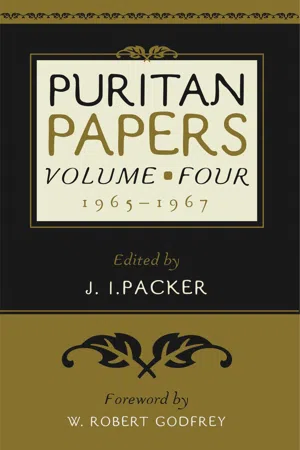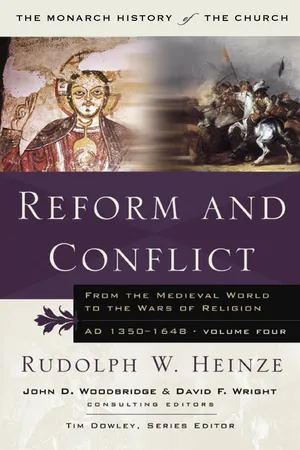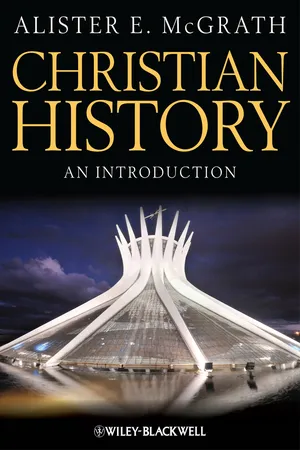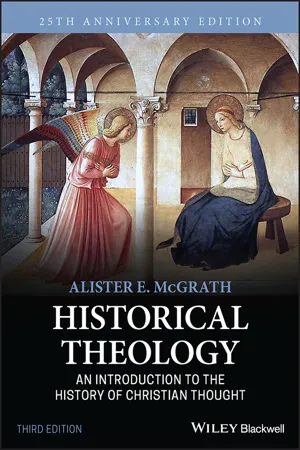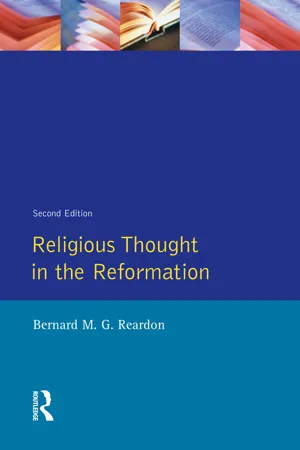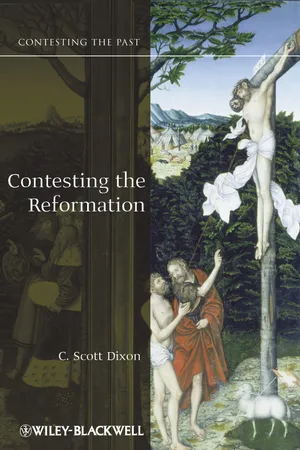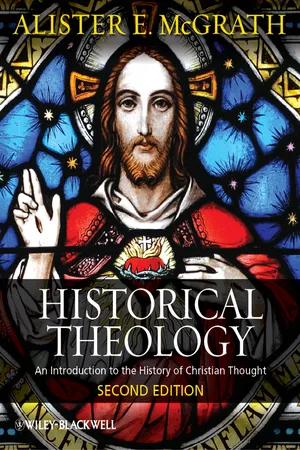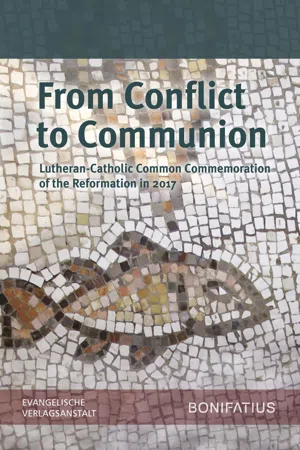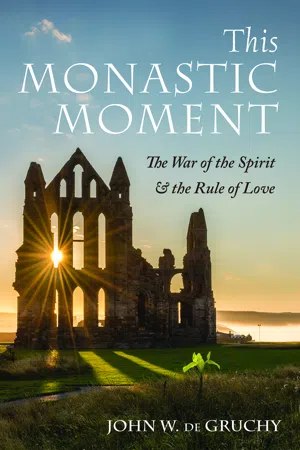History
Radical Reformation
The Radical Reformation was a 16th-century movement that sought to reform Christianity beyond the changes proposed by the Protestant Reformation. It encompassed various groups, including Anabaptists, Mennonites, and others who advocated for a more radical break from traditional Catholic and Protestant doctrines. The movement emphasized the importance of individual interpretation of the Bible and rejected infant baptism.
Written by Perlego with AI-assistance
Related key terms
11 Key excerpts on "Radical Reformation"
- eBook - ePub
- J. I. Packer(Author)
- 2004(Publication Date)
- P Publishing(Publisher)
The Anabaptists were part of a movement which has been variously described by recent historians as “the Left Wing of the Reformation” (J. T. McNeill and R. H. Bainton), or “the Radical Reformation” (G. H. Williams). The Radical Reformation, as I prefer to call it, was a complex movement, composed of heterogeneous elements. It included not only Anabaptists of various types, but also groups which exalted alleged revelations of the Spirit above the written word of Scripture, spiritualizers of varying tendencies, and what G. H. Williams calls Evangelical Rationalists. Grouped under the Radical Reformation one may find both political revolutionaries like Thomas Muntzer and pacifistic communitarians like Jacob Hutter. One may discover rigoristic legalists and antinomians, wild fanatics, and sober pietists. The Radical Reformation was, to employ the vivid image of Rufus Jones, a veritable banyan tree.Diverse though the elements were which constituted the Radical Reformation they were united by two basic convictions. The first was that the Protestant Reformation in Germany and Switzerland, its two chief centers, had not been nearly radical enough. In both countries, which were a patchwork of separate jurisdictions, the reformation of the Church had been largely carried out by the government of the day. Both Lutheranism and Calvinism had this in common, that they made an appeal to the “Christian magistrate” or the governing power as an instrument for the reformation of the Church.G. H. Williams has designated the Lutheran and Calvinist sections of the Reformation movement “the Magisterial Reformation.” He calls it such because its principle is reformation through the state. Basic to the Magisterial Reformation is the ideal of a Christian magistrate, the reform of the Church by means of the power of the state, an ideal which continued to be upheld even when it represented a small minority in a predominantly Catholic country. Intimately related to this ideal is a territorial conception of the Church. As the opposition of the Magisterial Reformers such as Luther, Zwingli, and Calvin to the principles of the Anabaptists increased, it was to become quite evident that their view of reformation depended upon their concept of a territorial Church which embraced all the citizens of an area or country in virtue of their baptism. When in 1531 Melanchthon drew up a memorandum on Anabaptism in which the death penalty was prescribed for recalcitrant Anabaptists, it is this territorial conception of the Church which is in the foreground. “What would happen,” he asks, “if children were not baptized, if not that our whole society would become openly heathen? . . . it is a serious matter to cast children out of Christendom and to have two sets of people, the one baptized and the other unbaptized. . . .” - eBook - ePub
Reform and Conflict
From the Medieval World to the Wars of Religion, AD 1350-1648, Volume Fo
- Rudoph W. Heinze, Tim Dowley(Authors)
- 2012(Publication Date)
- Monarch Books(Publisher)
These are some of the questions we will be confronting in this chapter, but the answers are not as clear as we might like. In contrast to what was called the Magisterial Reformation, because it was carried out with the cooperation of the established authorities or magistrates, the Radical Reformation splintered into many small sects with contrasting theologies and approaches to reform. The various groups that have traditionally been given the label “Anabaptist” were so different from each other that it is difficult to justify treating them together as a single movement. Even their methods of achieving reform differed radically, ranging from Michael Sattler’s pacifism to Thomas Müntzer’s readiness for, and even advocacy of, violence to achieve his goals. Historians writing about the Radical Reformation have added to the confusion because they have sometimes been more influenced by their preconceptions than by historical fact in arriving at their interpretations, which have varied so greatly over the centuries that it is difficult to believe they are talking about the same movement.Interpretations of the Radical ReformationBoth Protestant and Roman Catholic historians have described the Radical Reformation in a very negative way. The Magisterial Reformers considered the Anabaptists a threat to correct doctrine as well as to the proper order of society, and the radical, violent wing of the movement seemed to confirm their fears. Roman Catholics were equally intolerant of the Anabaptists, whom they considered to be a tool of the devil. Not surprisingly, the history written by historians representing those traditions was neither fair nor accurate.3 The twentieth century witnessed a dramatic change in Radical Reformation studies, which some historians have called “Free Church historiography.”4 Since scholars from mainline denominations had either neglected the study of the Radical Reformation or described the Anabaptists in a very negative way, a group of scholars—of whom Harold S. Bender, the editor of the Mennonite Quarterly Review , was the most prominent—sought to correct the misrepresentations. They were, as a rule, fine scholars, and the Mennonite tradition of historical studies certainly deserves our respect. However, since they were reacting against the unfair treatment of their tradition in earlier works, they tended at times to go to the opposite extreme. Although historians in this school acknowledged the abuses that took place in areas such as Münster, where a violent form of communal Anabaptism was established, they attributed these aberrations to persecution. The mainline Anabaptist movement, they maintained, was peaceful and tolerant, and its ongoing tradition was found in people such as Menno Simons and the Mennonites, who followed his teaching. They presented their forefathers as courageous believers who had kept the faith despite terrible persecution and who provided an impressive martyr tradition for their descendants. In the words of James Stayer, “the historiographical outcome was to make the ugly duckling of the Reformation into its most beautiful swan.”5 - John D. Woodbridge, Frank A. James III(Authors)
- 2013(Publication Date)
- Zondervan Academic(Publisher)
Although it was not his intention, Luther’s reform movement opened the floodgates of long-standing, deep-seated social and ecclesiastical discontent. In the words of historian George Huntston Williams, the Reformation impulse “drained the brackish pools and opened the sluices for innumerable religious currents long impounded in the interstices of late medieval Christendom.”At the outset, the modern student must distinguish between a “reformer” and a “revolutionary.” The magisterial reformers emphatically denied they were revolutionaries. They sought orderly reform through the city magistrates and princes — thus the term “magisterial.” The reformers sought to return and rebuild the true historic church, which they were convinced had been corrupted by centuries of greed and idolatry sanctioned by Rome.In his famous reply to Cardinal Jacopo Sadoleto (1539), Calvin speaks for all the Reformers: “all we have attempted has been to renew that ancient form of the Church, which … was afterward flagitiously mangled and almost destroyed by the Roman Pontiff and his faction.” The magisterial reformers ardently sought to distance themselves from the revolutionaries, who were viewed as anarchists, charlatans, or demon-possessed lunatics stirring up violent mobs of illiterate and uninformed peasantry. This pejorative assessment was shared by magisterial reformers and Catholic conservatives alike. Indeed, the greatest threat to a civil society was neither a Protestant nor a Catholic, but a radical.B. Radicals and AnabaptistsHistorian Lewis Spitz likened the Reformation to a banyan tree “sprouting a maze of roots and branches.” Among the maze that emerged from Luther’s revolt were disparate clusters of disgruntlement that have generally come to be known as Anabaptism or simply as “the Radicals.”Because of the complexity of this “other” movement (in contrast to the Lutheran and Reformed movements), it has resisted easy categorization and remains difficult to define, in part because it was not a single movement with a primary leader or a coherent set of doctrines. Rather, it was a series of reactions and ripostes, which were out of sync not only with the mainstream Reformers and Rome, but often with other so-called radicals. The most one can accomplish is to overview the general trends and distinctive themes of these multivalent reactions that quickly emerged in the wake of the main Protestant break with Rome.- eBook - ePub
Christian History
An Introduction
- Alister E. McGrath(Author)
- 2012(Publication Date)
- Wiley-Blackwell(Publisher)
sola scriptura principle (3.2.1) became radicalized. Christians were to believe and practice only what was explicitly taught in Scripture. There was no place for tradition or continuity with the past in the interpretation of the Bible. Every individual or community was free to interpret the Bible without reference to the Christian past. Old traditions might well be little more than ancient mistakes. This view reflects the distinctive view of the Radical Reformation that the true church ceased to exist shortly after the period of the apostles. Why appeal to the views of past writers, when these either had tarnished credentials, or were not even proper Christians? This point is of considerable importance, and needs further comment.For the magisterial reformers, such as Luther and Calvin, the task of the Reformation was to reform a church which had become corrupted or disfigured as a result of developments in the Middle Ages. The essential presupposition underlying this program should be noted carefully: to reform a church is to presuppose that a church already exists . Luther and Calvin were both clear that the medieval church was indeed a Christian church. It had lost its way and required to be reformed.The theologians of the radical wing of the Reformation, however, did not share this basic assumption. For them, the church had simply ceased to exist. How could the church be reformed, when there was no longer a church? It needed restoration, not reformation. By “reforming” the medieval church, Luther had merely altered the external appearance of a corrupt institution which had no right to call itself a Christian church. There was, radical writers declared, a need to recreate the church by purging non-biblical practices and beliefs.Anabaptist writers argued that a proper interpretation of the sola scriptura principle demanded that beliefs and practices – such as the baptism of infants – which were not specifically stated or endorsed in the Bible were to be uprooted. As the radical leader Balthasar Hubmaier (1480–1528) put this point in his Dialogue with Zwingli - eBook - ePub
Historical Theology
An Introduction to the History of Christian Thought
- Alister E. McGrath(Author)
- 2022(Publication Date)
- Wiley-Blackwell(Publisher)
A major new period in western Christian theology opened in the sixteenth century. The styles of Christian theology associated with the medieval period gave way to new paradigms. The most significant development was the period of reformation within the western European church, as a result of movements that sought to return the western church to more biblical foundations in relation to its belief system, morality, and structures. As Christianity was virtually landlocked within Europe at this stage in its history, these developments were destined to have a major impact subsequently on the subsequent global expansion of Christian theology.The Reformation initially led to the formation of a cluster of Protestant churches in Europe and subsequently to the renewal and reformation of the Catholic church in the same region – partly in response to the challenge of Protestantism and partly as a result of internal pressure for reform from within. These movements are often distinguished using the terms “Protestant Reformation” and “Catholic Reformation.” For historians, the importance of this period lies in the social and political consequences of the Reformations, leading to the division of Europe on religious and not merely national grounds, which laid the grounds for the Wars of Religion of the seventeenth century. Yet for our purposes in this volume, the real significance of the Reformation lies in its theological programmes and debates. We begin our discussion of this matter by considering and clarifying the terms used to refer to the various elements of this important period in theological history.Reformation – or Reformations?
The term “Reformation” is traditionally used by historians and theologians to refer to the western European movement, centering upon individuals such as Martin Luther, Huldrych Zwingli, and John Calvin, who were concerned with the theological, moral, and institutional reform of the Christian church in that region. The Reformation movement was complex and heterogeneous, and its agenda went far beyond the reform of church teachings and practices. It addressed fundamental social, political, and economic issues, too complex to be discussed in any detail in this volume. The agenda of the Reformation varied from one country to another, with the theological issues that played major roles in one country (for example, Germany) often having relatively little impact elsewhere (for example, in England). - eBook - ePub
- Bernard M. G. Reardon(Author)
- 2014(Publication Date)
- Routledge(Publisher)
1Important as has been the modern revival of scholarly interest in the leaders of classical Protestantism, it does not surpass that of parallel study of the history of the radicals, or the anabaptists as they used as a whole, but not very accurately, to be called; for what has signalized research in this field is the great amount of newly discovered and edited source materials as well as the not at all easy task of general reassessment.Even now, as one of the principal contributors to this work, the American scholar G. H. Williams, has stated, it would be premature to attempt a definitive account of the ‘radical’ Reformation. For our very limited purpose here, however, the emerging picture is clear enough to enable us to present certain summary impressions. At the very least one is not likely to question Professor Williams’s judgement that Tor good or ill, the Radicals were to shape the contours of the world that was to come after them far more than they or their Catholic and Protestant opponents realized’.2It is nowadays usual to classify the diverse and in certain instances widely disparate radical or ‘left-wing’ elements of the Reformation movement into three groups, the anabaptists proper, the spirituals, and the rationalists,3 though an excessive rigidity of classification should not be attempted, since overlapping is frequent and at times it is difficult to say precisely to what type a given individual belongs. Thus if anabaptists like Balthasar Hubmaier or Menno Simons are fitly described as evangelical, it would nonetheless be misleading to deny the epithet to the rationalists, while the so-called spirituals are for their part so variegated in appearance that no sharp dividing line can be drawn between them and the other two groups. Again, it would be a mistake to represent Reformation radicalism as a self-consistent movement. The radicals were indeed fervent for reform, root and branch, but they definitely cannot be said to have organized reformist campaigns after the manner of the Lutherans, the Zwinglians and the Calvinists. At no time did they produce a great spiritual leader, nor did they have any common body of doctrine – the Schleitheim Articles - eBook - ePub
- C. Scott Dixon(Author)
- 2012(Publication Date)
- Wiley-Blackwell(Publisher)
44By the dawn of the twentieth century the sheer volume of work on the German Reformation had become overwhelming. No single scholar could hope to master it all. Instead, historians turned to theory, models, and paradigms to cut through the details and speak in terms of cause and effect. Among the earliest to apply theory to the study of the Reformation were the Marxists, the first being Friedrich Engels (1820–1895), Karl Marx’s long-time friend and collaborator. In his work The Peasant War in Germany (1850), Engels surveyed the early evangelical movement from a Marxist perspective. The result was a work which tied the event to the social, political, and economic conditions of the day. He also introduced new categories to the debate, including questions relating to class, revolutionary groupings, and the different levels of reception. The Marxist interpretation remained influential throughout the twentieth century, with fundamental contributions to the field coming from the Russian scholar M. M. Smirin’s study of Thomas Müntzer and the east German historian Max Steinmetz, who claimed that Luther’s ideas were “the theological expression of the economic and political struggle between the bourgeoisie and the masses of people against the Church of the Pope which was governed by Rome and which hampered any social progress.”45 In western Europe, other models emerged in the works of social scientists, the most famous and influential being the extended essay The Protestant Ethic and the Spirit of Capitalism (1904/5) by Max Weber (1864–1920). Weber identified features of the Protestant faith (in particular, what he termed its “worldly asceticism”) that had a direct affinity with features of modern capitalism. This model, much like the Marxist model, tied religious ideas to the social and political conditions of the day (though Weber granted faith a causal role).46 In a similar spirit, Troeltsch offered an approach in The Social Teaching of the Christian Churches - eBook - ePub
Historical Theology
An Introduction to the History of Christian Thought
- Alister E. McGrath(Author)
- 2012(Publication Date)
- Wiley-Blackwell(Publisher)
The Reformation itself was a western European phenomenon, concentrated especially in the central and northern parts of this region, although Calvinism penetrated as far east as Hungary. However, the emigration of large numbers of individuals to North America, which becomes increasingly significant from 1600 onward, led to post-Reformation Protestant and Catholic theologies being exported to that region. Harvard College is an example of an early center of theological education in New England. The Society of Jesus also undertook extensive missionary operations in the Far East, including India, China, and Japan. Christian theology gradually began to expand beyond its western European base and become a global phenomenon – a development which received final consolidation in the modern period, to which we shall turn shortly. Our attention now turns to a consideration of the terminology linked with the Reformation and post-Reformation periods.A Clarification of Terms
Precisely because the movement that is called “the Reformation” is so complex, it is used in a number of different senses. This point is sometimes emphasized by using the plural form “reformations,” which draws attention to the undisputable historical fact that there were a number of reforming movements in western Europe at this time, often with different geographical locations and religious agenda. Six meanings of the term are encountered in the literature: the German Reformation, which gave rise to Lutheranism; the Swiss Reformation, which gave birth to the Reformed version of Christianity often referred to as “Calvinism”; the “Radical Reformation,” often still referred to as “Anabaptism”; the English Reformation, which gave rise to the distinctive form of Christianity often known as “Anglicanism”; the “Catholic Reformation” (sometimes referred to as the “Counter-Reformation”); and the “Second Reformation” within Protestantism. In its broadest sense, the term “Reformation” is used to refer to all these movements.The term “Protestant” requires comment. It derives from the aftermath of the Diet of Speyer (February 1529), which voted to end the toleration of Lutheranism in Germany. In April of the same year, six German princes and 14 cities protested against this oppressive measure, defending freedom of conscience and the rights of religious minorities. The term “Protestant” derives from this protest. It is therefore not strictly correct to apply the term “Protestant” to individuals prior to April 1529, or to speak of events prior to that date as constituting “the Protestant Reformation.” The term “evangelical” is often used in the literature to refer to the reforming factions at Wittenberg and elsewhere (e.g., in France and Switzerland) prior to this date. Although the word “Protestant” is often used to refer to this earlier period, this use is, strictly speaking, an anachronism. - Michael Mullett(Author)
- 2023(Publication Date)
- Routledge(Publisher)
CHAPTER 3 Religious Radicalism and the Protestant ReformationIn 1518 Martin Luther saw to the publication of the late-mediaeval devotional work, the Theologia Deutsch (German Theology). Luther was interested in the discovery and re-issue of such mediaeval religious works, especially when they had a Wyclifite or Hussite origin which might establish the existence of a tradition of religious dissent throughout the centuries of papal dominance.1 Luther’s problem was that, alone, he seemed to be challenging many centuries of Catholic belief. The answer to this charge was to turn history against the orthodox by producing the pedigree of religious nonconformity. Research into ecclesiastical history with the aim of proving that the Protestant Reformation had roots deep in the mediaeval past became a preoccupation of Reformation scholarship and resulted in masterpieces of Protestant historical writing, such as Flacius Illyricus Magdeburg Centuries. But the efforts of Luther and his disciples, especially with regard to the publication of mediaeval religious works, brought to light not only the existence of mediaeval dissent but also the vitality of mediaeval lay religion. This lay religion provided a seed-bed for the growth of religious radicalism, but its emergence was also an achievement of the mediaeval Church, whose constant missionising, preaching and publishing had their effect in creating a pious Christian people.The formation of the devout laity was the work of the institutional Church. Clerics acted as influential urban preachers; they wrote some of the most widely read pious treatises; they acted as chaplains to guilds, beguinages and confraternities. Above all, as confessors, writers, preachers and authors, clerics acted as highly responsible mediators between official doctrine and the religious needs of the laity. In this last function university-trained clerics, such as Meister Eckhart, popularised the doctrine and philosophy of the Church. This work of popularisation was performed in part by simple, but sometimes inspired, translations of Latin technical terms into their vernacular equivalents. Thus the Latin term for the concept of the ‘spark’ of divinity in the human soul – the Scintilla – was rendered into German as Seelenfünklein – literally ‘little soul spark’ – a key term in the vocabulary of later mediaeval German mysticism. But successful spiritual counsel on the part of clergymen necessitated more than the invention of a new vocabulary. What was required was a fusion between the mind of the counsellor and those of his auditors and readers. The popularisation of religious thought in response to the needs of lay, conventual and semi-conventual people – apparent, for example, in the Rhineland and the Low Countries – helped produce a flowering of mediaeval mysticism and pietism. In this context lay people, or individuals enrolled in semi-regular order like the Beguines, could themselves assume the initiative from their spiritual guides and produce authentic works of devotion and mysticism. This lay and vernacular piety was a major contributing factor in the enlargement of the individual consciousness, which is a key feature of late mediaeval and early modern European civilisation.2- eBook - ePub
From Conflict to Communion – Including Common Prayer
Lutheran-Catholic Common Commemoration of the Reformation in 2017 Report of the Lutheran-Roman Catholic Commission on Unity
- The Lutheran World Federation(Author)
- 2016(Publication Date)
- Evangelische Verlagsanstalt(Publisher)
HAPTER IIIA HISTORICAL SKETCH OF THE LUTHERAN REFORMATION AND THE CATHOLIC RESPONSE
35. Today we are able to tell the story of the Lutheran Reformation together. Even though Lutherans and Catholics have different points of view, because of ecumenical dialogue they are able to overcome traditional anti-Protestant and anti-Catholic hermeneutics in order to find a common way of remembering past events. The following chapter is not a full description of the entire history and all the disputed theological points. It highlights only some of the most important historical situations and theological issues of the Reformation in the sixteenth century.WHAT DOES REFORMATION MEAN ?36. In antiquity, the Latin noun reformatio referred to the idea of changing a bad present situation by returning to the good and better times of the past. In the Middle Ages, the concept of reformatio was very often used in the context of monastic reform. The monastic orders engaged in reformation in order to overcome the decline of discipline and religious lifestyle. One of the greatest reform movements originated in the tenth century in the Abbey of Cluny.37. In the late Middle Ages, the concept of the necessity of reform was applied to the whole church. The church councils and nearly every diet of the Holy Roman Empire were concerned with reformatio. The Council of Constance (1414–1418) regarded the reform of the church »in head and members« as necessary.9 A widely disseminated reform document entitled »Reformacion keyser Sigmunds« called for the restoration of right order in almost every area of life. At the end of the fifteenth century, the idea of reformation also spread to the government and university.10 - eBook - ePub
This Monastic Moment
The War of the Spirit & the Rule of Love
- John W. de Gruchy(Author)
- 2021(Publication Date)
- Cascade Books(Publisher)
But the support he received from some German princes inevitably undermined the unity of both the church and the empire. Christendom was necessary whether for Luther in Germany, Zwingli in Zurich, Calvin in Geneva, or those who followed them. They had to depend on the support of princes and magistrates to pursue their objectives, and accordingly argued that the authorities had the divine duty to protect the church and further the objectives of the Reformation. For this reason, they are often referred to as the magisterial Reformers as distinct from those designated radical Reformers, who are normally grouped together as Anabaptists—those who rejected Christendom in their attempt to restore the apostolic ecclesia. 341 The Anabaptist movement first emerged in Zurich within Zwingli’s domain but soon formed its own congregations. Zwingli’s reforms, necessary as they were, were considered inadequate, and the Anabaptists were not prepared to wait for the city council to approve their own demands. 342 What was needed, they insisted, was a return to the roots of the New Testament ecclesia (hence they are called the radical Reformers) and the restoration of its original, apostolic pattern. Their rejection of infant baptism in favor of believer’s baptism (for which reason they were called rebaptizers, or anabaptists, by their opponents) was an affirmation of costly discipleship and a break with a worldly church, a break as radical as taking monastic vows. And often the discipline exercised within their communities was similar to monastic discipline. Their condemnation and persecution, by the Reformers as heretics and by the authorities as subversives, led to widespread martyrdom, graphically documented in the seventeenth-century Martyrs’ Mirror
Index pages curate the most relevant extracts from our library of academic textbooks. They’ve been created using an in-house natural language model (NLM), each adding context and meaning to key research topics.
